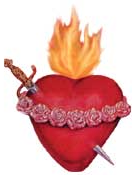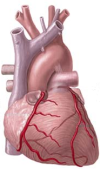Heart Cross
Why a Heart?
The Heart Cross is any cross (for example a Latin Cross) which is adorned with one or more heart symbols. There are innumerable variations; this page shows some popular designs and explores the reasons for including a heart on a cross.

Christ's Crucifixion was enveloped in love

The cross consists only of love

We have lots of organs in our body, so why should the heart, rather than the brain, eye, hand, or any other part of the body, be the symbol that has become synonymous with 'love'?
The heart is quite a remarkable organ. Each beat is triggered by a surge of calcium ions that causes millions of overlapping proteins (actin and myosin) in each heart cell to pull against each other and contract. How's that for sustainable renewable energy!
When we run, when we are excited, our heart beats faster; when we sleep, our heart beats slower; and when we die, it doesn't beat at all. So it must have been understood for a long time that the heart has an important correlation with life - a significant, if not the most significant, part of our body.
Thrust a spear into somebody's abdomen and they survive for a while. Pierce their heart and they die immediately. It doesn't take much extension of the imagination to associate this organ with deeper aspects of life, such as the soul and emotions. The deepest emotion, love, is therefore associated with the most significant organ, the heart.

Interestingly (well OK, maybe not so interesting) there are two Asian characters for 'love': (1) and (2). You will notice both characters include the same element, and that character happens to mean 'heart' (3).
"I'll put my heart into it" means I'll give it my utmost attention and effort. We use the word heart as a metaphor for several things: courage, effort, interest etc., but above all these, the heart means love. "I give my heart to you. Open your heart for me." means I love you and want you to accept it.
It comes as no surprise, therefore, that the heart is used in many church logos, including that of the Society of St. Pius X (SSPX), shown on the right with a crown.
The Heart Cross represents and reminds us of the love of Jesus. And this is lovable; we can devote ourselves to the love shown by God,
So the heart symbol can represent the love from God, or the love we give to God, which in turn means the love we give to other people. In this context it is often referred to as the Sacred Heart.
Immaculate heart

When an image of a heart is pierced by a sword, this depicts the Immaculate Heart of Mary. Sometimes the image shows seven swords piercing the heart, in homage to the seven dolors of Mary.
The sword-piercing is in reference to Simeon's prophecy when Mary presented Jesus at the temple. (See Luke 2:25-35)
Related images often have a string of roses or lilies wrapped around the heart.
Why the ♥ shape?

So much for the organ and its use to represent love. But what about its easily-recognisable but biologically-unsound shape?
It is often coloured bright red to symbolise life and vitality, but there's no anatomical accuracy in the symbol and not much similarity between the symbolism and the physical organ. Nevertheless, they do share one fundamental attribute: neither the physical heart nor the spiritual heart can function without a host.
The heart, in a physical sense or spiritual sense, is inseparably connected with the physical or spiritual life. It's of no use to say that one loves Jesus unless we back this up with loving action in our daily lives. Conversely, any religious activities we do shouldn't come from a sense of obligation or duty; they should be done with love (yes, from our hearts). This, after all, is what the Bible instructs (see Eph. 2:8-10).
Here's one idea of where the shape originates:
In the ancient Greek city of Cyrene (in Libya) they grew a herb called silphium. Silphium was used as a seasoning in cooking and also a herbal medicine for cough, fever and other maladies. It was so important to Cyrene's economy that the plant was inscribed on coins of that period (6th–5th century BCE). Although the plant is now extinct, the surviving coins give us a good idea of what silphium seed pods looked like.
The most prized use of the herb was its contraceptive properties, both in preventing and aborting pregnancies. This plant is attributed to the Greek god Apollo (god of medicine and healing) who had his fair share of lovers (male and female). Of course, that's procreation and romantic passion, not love.
Classical writers such as Theophrastus and Pliny the Elder described the plant and its uses in detail, including mentions of its shape and significance. Though their descriptions are textual, they complement the visual clues.
Around the 13th–14th century, artists and scholars began to depict the human heart based on anatomical studies. These representations, influenced by Aristotle's descriptions, contributed to the stylized heart shape. He described the heart as having three chambers, with a pointed end — like a triangle or a flame. He believed the heart had a rounded top and a tapering bottom, similar to a conical or fig-like shape.
Stylized depictions of ivy leaves (another love symbol) may also have influenced the design, and by the Renaissance, the heart symbol had become widely associated with romantic love. ♡


Alternative histories probably exist, but the above version is the best we've found.
And it doesn't matter much; the important thing is love, and the heart symbol reminds us of love. Whether it's on a cross, a playing card or a valentine card, the symbol reminds us of somebody's love toward us. (See other Romantic Crosses)
Dogwood Cross
The Bible doesn't specify what species of tree was used to crucify Jesus, but romantics have suggested it was a dogwood tree. (Spoiler: Dogwood is not native to Judaea.)
The tree bears edible berries; not very tasty but suitable as dog food. That may be the etymology of the name, or it may be because the hard wood is suitable for making skewers and daggers. Whatever the origin, the small flowers produced in springtime usually have four heart-shaped petals.
Since springtime in the Northern hemisphere coincides with Easter, these heart-shaped petals of the dogwood tree have been used in poetry:
The Dogwood Tree
by Anonymous
When Christ was on earth, the dogwood grew
To a towering size with a lovely hue.
Its branches were strong and interwoven
And for Christ's cross its timbers were chosen
Being distressed at the use of the wood
Christ made a promise which still holds good:
"Not ever again shall the dogwood grow
To be large enough for a tree, and so
Slender and twisted it shall always be
With cross-shaped blossoms for all to see.
The petals shall have bloodstains marked brown
And in the blossom's centre a thorny crown.
All who see it will think of Me,
Nailed to a cross from a dogwood tree.
Protected and cherished this tree shall be
A reflection to all of My agony."
Shamrock Cross
There are other four-petalled heart-shaped (cordiform) flowers, and plants with four distinctive leaves, such as the "lucky" four-leafed clover.
Many trees also have cordiform leaves; in fact cordiform petals and leaves seem to be the most common shape.
Four hearts?
Do four hearts have any special symbolism? Yes, they probably do.
As with any symbol, the meaning of four hearts is whatever we interpret it to be, and when "four" is mentioned in the Bible it does have special significance.
For example, when Jesus' body was taken down from the cross, the soldiers tore his clothes into four pieces as souvenirs (John 19:23). Those four pieces were distributed, just as Jesus had instructed his disciples to distribute the Gospel to the whole world; that is, to the four "corners" of the earth. (Matt. 28:18-20).
Four of those disciples have given us the four Canonical Gospels which focus so much on the love of Jesus. Those are not mere commentaries; they are the heart of Christianity.
A symbol of love
As pointed out above, the heart symbol ♥ looks nothing like the physical organ which helps to keep us alive, and sometimes the symbol's shape is altered to signify the feeling of a broken or saddened emotional heart, such as the tear-drop shape on the stem of the cross on this grave in an old Brazilian cemetery (closed in the 1920s).
The heart has been associated with love since ancient times. The Christian cross also, is a symbol of love.
The Heart Cross helps us to focus our thoughts on this love.
This page is dedicated to the loving memory of Edward Richards, who died of a heart attack whilst this webpage was being built. He was a man who gave his love so freely and was greatly loved by his family and friends.

Rest in peace Eddy
A similar plant is asafetida, which is still used for cooking in Central Asia today.



